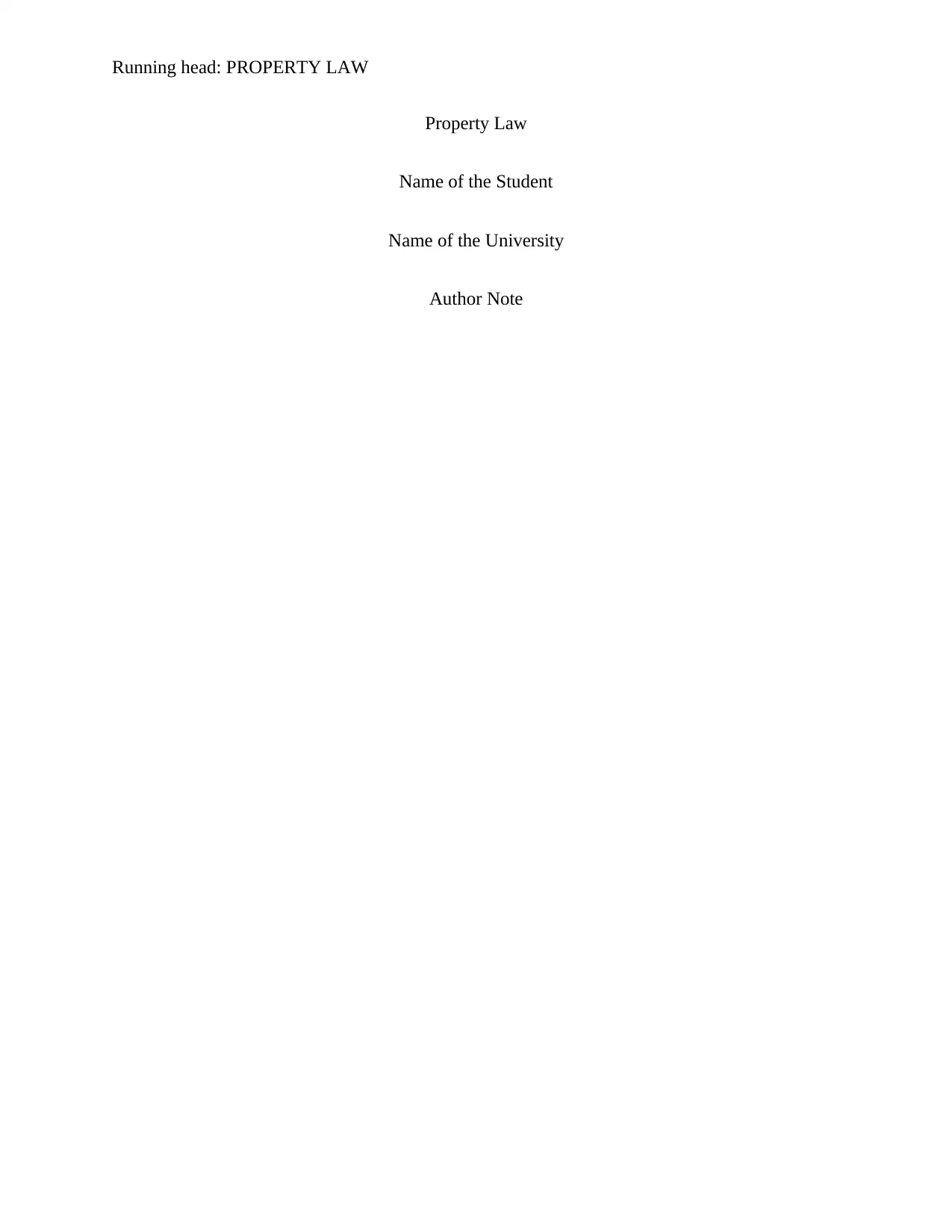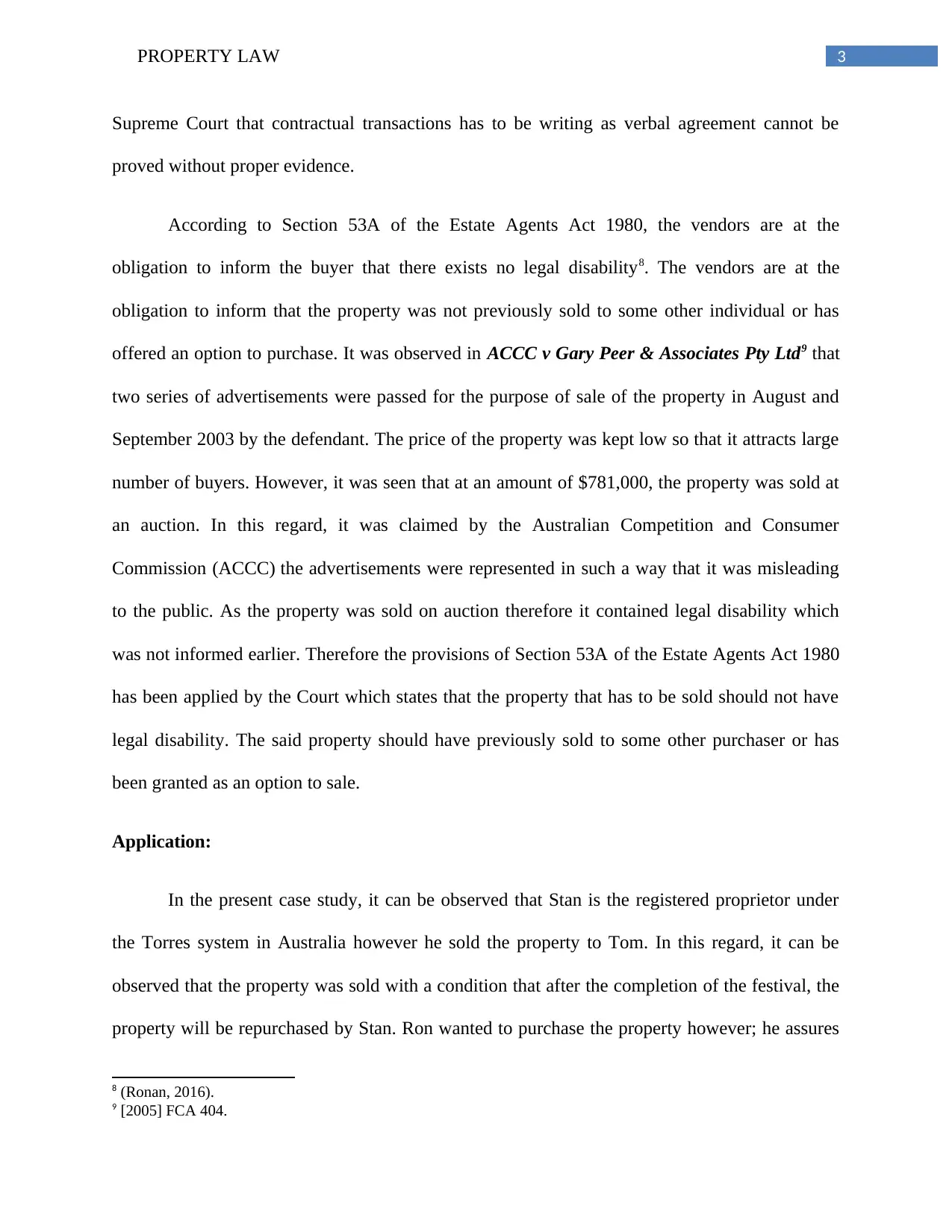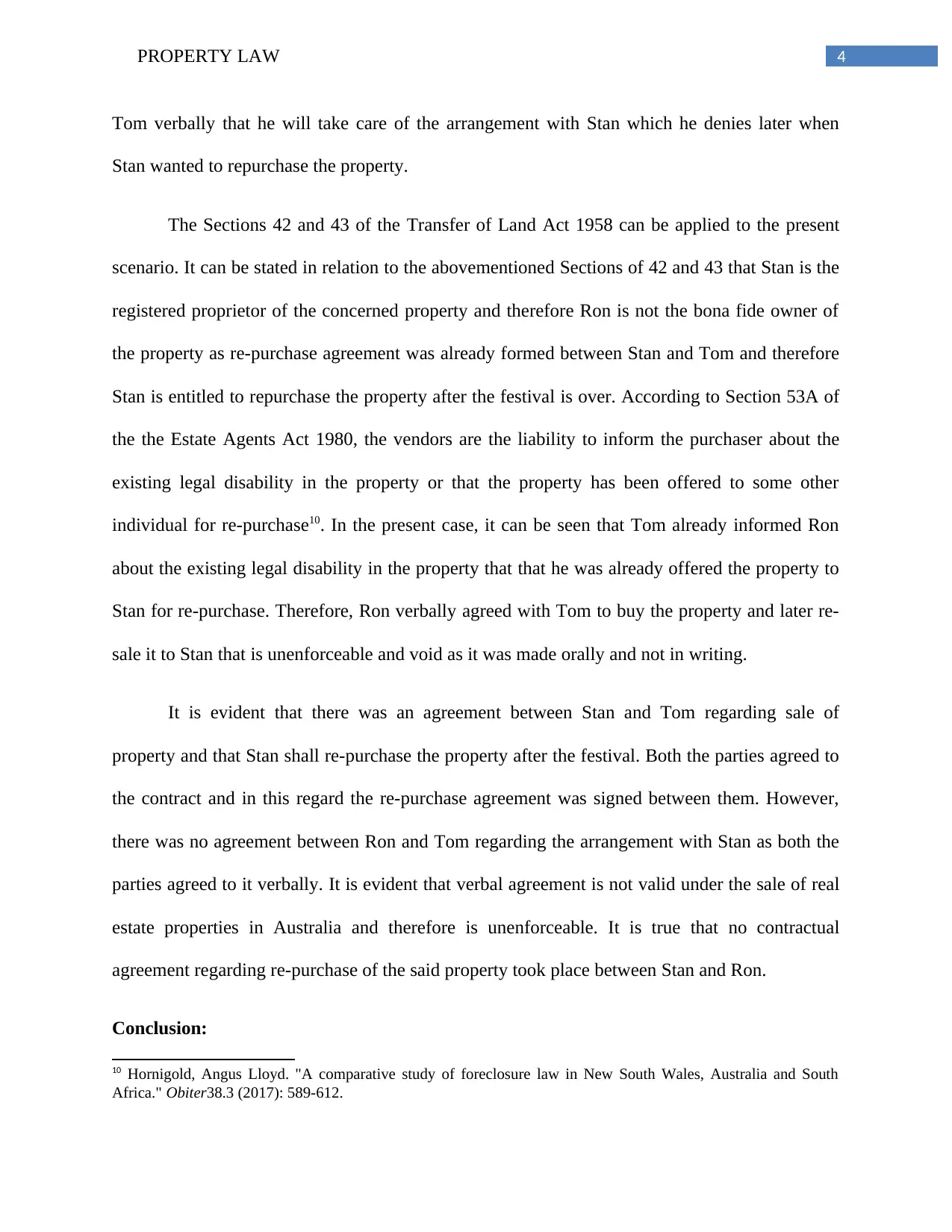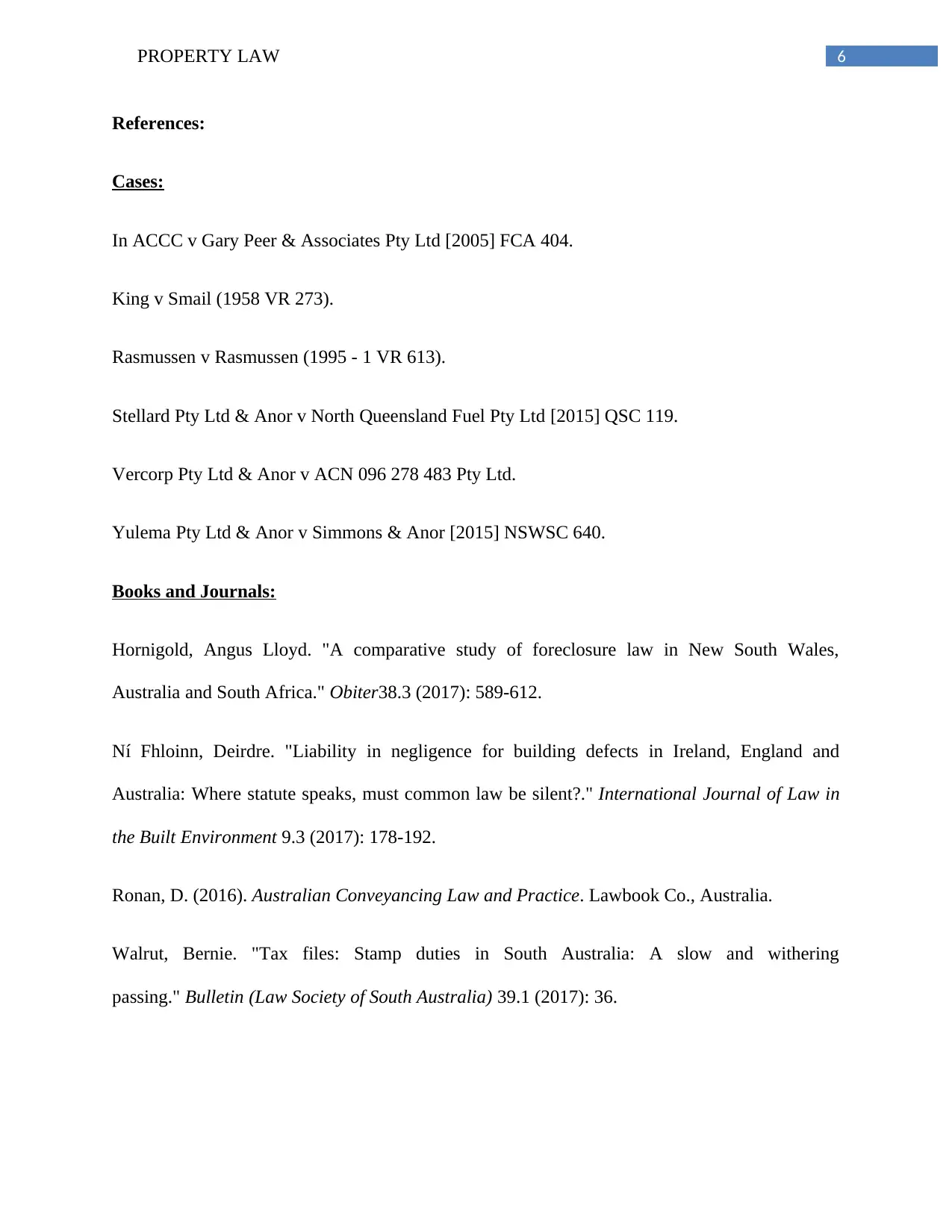Property Law: Repurchase of Property in Australia
VerifiedAdded on 2023/06/14
|8
|1704
|401
AI Summary
This article discusses the legalities of repurchasing a property in Australia under the Torrens system. It explains the importance of a written contract and the liability of vendors to inform buyers of legal disabilities. The case study presented in the article highlights the application of Sections 42 and 43 of the Transfer of Land Act 1958 and Section 53A of the Estate Agents Act 1980.
Contribute Materials
Your contribution can guide someone’s learning journey. Share your
documents today.

Running head: PROPERTY LAW
Property Law
Name of the Student
Name of the University
Author Note
Property Law
Name of the Student
Name of the University
Author Note
Secure Best Marks with AI Grader
Need help grading? Try our AI Grader for instant feedback on your assignments.

1PROPERTY LAW
Issue:
The issue that has been observed in this case is that will Stan be able to repurchase the
property from Ron.
Rule:
It is evident that privately owned land is regulated under the Torrens system in Australia.
In Australia, conveyance is defined as the transfer of legal title which involves either land or real
estate from one individual to another. In this regard, it is noteworthy to mention here that a
conveyance transaction takes place when both the parties to sale enter into contract of sale1.
However, it is important on the part of the buyer to ensure that the title obtained by him in
relation to the property is good and marketable. Therefore, the right to sell the property is
entrusted to the owner and there should be no hidden condition as to re-sale or mortgage of the
said property. In this regard, the provisions of Section 42 and Section 43 of the Transfer of Land
Act 1958 are applicable. Section 42 deals with estate of registered proprietor paramount while
Section 43 deals with individuals falling under registered proprietor who are not affected by
notice. In Rasmussen v Rasmussen (1995 - 1 VR 613)2 it was observed that the property passed
to one of the grandsons of the owner even the son of the owner was the registered proprietor of
the concerned property. Therefore, Sections 42 and 43 has been applied by the Court and held
that the father was not bona fide purchaser of the property and therefore the ownership of the
property shall be granted to the grandsons.
1 Ní Fhloinn, Deirdre. "Liability in negligence for building defects in Ireland, England and Australia: Where statute
speaks, must common law be silent?." International Journal of Law in the Built Environment 9.3 (2017): 178-192.
2 (1995 - 1 VR 613).
Issue:
The issue that has been observed in this case is that will Stan be able to repurchase the
property from Ron.
Rule:
It is evident that privately owned land is regulated under the Torrens system in Australia.
In Australia, conveyance is defined as the transfer of legal title which involves either land or real
estate from one individual to another. In this regard, it is noteworthy to mention here that a
conveyance transaction takes place when both the parties to sale enter into contract of sale1.
However, it is important on the part of the buyer to ensure that the title obtained by him in
relation to the property is good and marketable. Therefore, the right to sell the property is
entrusted to the owner and there should be no hidden condition as to re-sale or mortgage of the
said property. In this regard, the provisions of Section 42 and Section 43 of the Transfer of Land
Act 1958 are applicable. Section 42 deals with estate of registered proprietor paramount while
Section 43 deals with individuals falling under registered proprietor who are not affected by
notice. In Rasmussen v Rasmussen (1995 - 1 VR 613)2 it was observed that the property passed
to one of the grandsons of the owner even the son of the owner was the registered proprietor of
the concerned property. Therefore, Sections 42 and 43 has been applied by the Court and held
that the father was not bona fide purchaser of the property and therefore the ownership of the
property shall be granted to the grandsons.
1 Ní Fhloinn, Deirdre. "Liability in negligence for building defects in Ireland, England and Australia: Where statute
speaks, must common law be silent?." International Journal of Law in the Built Environment 9.3 (2017): 178-192.
2 (1995 - 1 VR 613).

2PROPERTY LAW
Similarly, in King v Smail 1958 VR 2733 it was observed that both the husband and the
wife were registered proprietors of the land and enjoyed joint ownership. However, the husband
transferred his part of the interest as a gift without prior concern of his wife. After transfer of
interest, the wife has a query regarding the fact that the ownership to the land was jointly held
and therefore she had same interest to the ownership as her husband. In Vercorp Pty Ltd & Anor
v ACN 096 278 483 Pty Ltd4 it was seen that the plaintiffs agreed the sell the four existing vacant
lands to Barrier Developments however; it was observed that the plaintiffs did not held actual
title to the property and therefore the respondent were bound to follow the principles of the
nominated owner.
It can be mentioned that in order to buy a real estate property in Australia, it is important
that the contract of sale bust be duly signed by both the parties5. However, it is important that
such contract of sale must be in writing because verbal contracts for real estate properties are
unenforceable which was held in a recent case of Stellard Pty Ltd & Anor v North Queensland
Fuel Pty Ltd [2015] QSC 1196 where it was observed that the parties to the sale contract
exchanged e-mails and communicated with each other verbally. The negotiations of pre-
contractual contract were agreed by them without even signing the contract. Therefore, it was
held by the Court that if the contract is not written and the parties to it has not given their consent
by signing it then the contract is unenforceable and cannot be used for re-purchase in the future.
In Yulema Pty Ltd & Anor v Simmons & Anor [2015] NSWSC 6407 it was held by the NSW
3 (1958 VR 273).
4 096 278 483.
5 Walrut, Bernie. "Tax files: Stamp duties in South Australia: A slow and withering passing." Bulletin (Law Society
of South Australia) 39.1 (2017): 36.
6 [2015] QSC 119.
7 [2015] NSWSC 640.
Similarly, in King v Smail 1958 VR 2733 it was observed that both the husband and the
wife were registered proprietors of the land and enjoyed joint ownership. However, the husband
transferred his part of the interest as a gift without prior concern of his wife. After transfer of
interest, the wife has a query regarding the fact that the ownership to the land was jointly held
and therefore she had same interest to the ownership as her husband. In Vercorp Pty Ltd & Anor
v ACN 096 278 483 Pty Ltd4 it was seen that the plaintiffs agreed the sell the four existing vacant
lands to Barrier Developments however; it was observed that the plaintiffs did not held actual
title to the property and therefore the respondent were bound to follow the principles of the
nominated owner.
It can be mentioned that in order to buy a real estate property in Australia, it is important
that the contract of sale bust be duly signed by both the parties5. However, it is important that
such contract of sale must be in writing because verbal contracts for real estate properties are
unenforceable which was held in a recent case of Stellard Pty Ltd & Anor v North Queensland
Fuel Pty Ltd [2015] QSC 1196 where it was observed that the parties to the sale contract
exchanged e-mails and communicated with each other verbally. The negotiations of pre-
contractual contract were agreed by them without even signing the contract. Therefore, it was
held by the Court that if the contract is not written and the parties to it has not given their consent
by signing it then the contract is unenforceable and cannot be used for re-purchase in the future.
In Yulema Pty Ltd & Anor v Simmons & Anor [2015] NSWSC 6407 it was held by the NSW
3 (1958 VR 273).
4 096 278 483.
5 Walrut, Bernie. "Tax files: Stamp duties in South Australia: A slow and withering passing." Bulletin (Law Society
of South Australia) 39.1 (2017): 36.
6 [2015] QSC 119.
7 [2015] NSWSC 640.

3PROPERTY LAW
Supreme Court that contractual transactions has to be writing as verbal agreement cannot be
proved without proper evidence.
According to Section 53A of the Estate Agents Act 1980, the vendors are at the
obligation to inform the buyer that there exists no legal disability8. The vendors are at the
obligation to inform that the property was not previously sold to some other individual or has
offered an option to purchase. It was observed in ACCC v Gary Peer & Associates Pty Ltd9 that
two series of advertisements were passed for the purpose of sale of the property in August and
September 2003 by the defendant. The price of the property was kept low so that it attracts large
number of buyers. However, it was seen that at an amount of $781,000, the property was sold at
an auction. In this regard, it was claimed by the Australian Competition and Consumer
Commission (ACCC) the advertisements were represented in such a way that it was misleading
to the public. As the property was sold on auction therefore it contained legal disability which
was not informed earlier. Therefore the provisions of Section 53A of the Estate Agents Act 1980
has been applied by the Court which states that the property that has to be sold should not have
legal disability. The said property should have previously sold to some other purchaser or has
been granted as an option to sale.
Application:
In the present case study, it can be observed that Stan is the registered proprietor under
the Torres system in Australia however he sold the property to Tom. In this regard, it can be
observed that the property was sold with a condition that after the completion of the festival, the
property will be repurchased by Stan. Ron wanted to purchase the property however; he assures
8 (Ronan, 2016).
9 [2005] FCA 404.
Supreme Court that contractual transactions has to be writing as verbal agreement cannot be
proved without proper evidence.
According to Section 53A of the Estate Agents Act 1980, the vendors are at the
obligation to inform the buyer that there exists no legal disability8. The vendors are at the
obligation to inform that the property was not previously sold to some other individual or has
offered an option to purchase. It was observed in ACCC v Gary Peer & Associates Pty Ltd9 that
two series of advertisements were passed for the purpose of sale of the property in August and
September 2003 by the defendant. The price of the property was kept low so that it attracts large
number of buyers. However, it was seen that at an amount of $781,000, the property was sold at
an auction. In this regard, it was claimed by the Australian Competition and Consumer
Commission (ACCC) the advertisements were represented in such a way that it was misleading
to the public. As the property was sold on auction therefore it contained legal disability which
was not informed earlier. Therefore the provisions of Section 53A of the Estate Agents Act 1980
has been applied by the Court which states that the property that has to be sold should not have
legal disability. The said property should have previously sold to some other purchaser or has
been granted as an option to sale.
Application:
In the present case study, it can be observed that Stan is the registered proprietor under
the Torres system in Australia however he sold the property to Tom. In this regard, it can be
observed that the property was sold with a condition that after the completion of the festival, the
property will be repurchased by Stan. Ron wanted to purchase the property however; he assures
8 (Ronan, 2016).
9 [2005] FCA 404.
Secure Best Marks with AI Grader
Need help grading? Try our AI Grader for instant feedback on your assignments.

4PROPERTY LAW
Tom verbally that he will take care of the arrangement with Stan which he denies later when
Stan wanted to repurchase the property.
The Sections 42 and 43 of the Transfer of Land Act 1958 can be applied to the present
scenario. It can be stated in relation to the abovementioned Sections of 42 and 43 that Stan is the
registered proprietor of the concerned property and therefore Ron is not the bona fide owner of
the property as re-purchase agreement was already formed between Stan and Tom and therefore
Stan is entitled to repurchase the property after the festival is over. According to Section 53A of
the the Estate Agents Act 1980, the vendors are the liability to inform the purchaser about the
existing legal disability in the property or that the property has been offered to some other
individual for re-purchase10. In the present case, it can be seen that Tom already informed Ron
about the existing legal disability in the property that that he was already offered the property to
Stan for re-purchase. Therefore, Ron verbally agreed with Tom to buy the property and later re-
sale it to Stan that is unenforceable and void as it was made orally and not in writing.
It is evident that there was an agreement between Stan and Tom regarding sale of
property and that Stan shall re-purchase the property after the festival. Both the parties agreed to
the contract and in this regard the re-purchase agreement was signed between them. However,
there was no agreement between Ron and Tom regarding the arrangement with Stan as both the
parties agreed to it verbally. It is evident that verbal agreement is not valid under the sale of real
estate properties in Australia and therefore is unenforceable. It is true that no contractual
agreement regarding re-purchase of the said property took place between Stan and Ron.
Conclusion:
10 Hornigold, Angus Lloyd. "A comparative study of foreclosure law in New South Wales, Australia and South
Africa." Obiter38.3 (2017): 589-612.
Tom verbally that he will take care of the arrangement with Stan which he denies later when
Stan wanted to repurchase the property.
The Sections 42 and 43 of the Transfer of Land Act 1958 can be applied to the present
scenario. It can be stated in relation to the abovementioned Sections of 42 and 43 that Stan is the
registered proprietor of the concerned property and therefore Ron is not the bona fide owner of
the property as re-purchase agreement was already formed between Stan and Tom and therefore
Stan is entitled to repurchase the property after the festival is over. According to Section 53A of
the the Estate Agents Act 1980, the vendors are the liability to inform the purchaser about the
existing legal disability in the property or that the property has been offered to some other
individual for re-purchase10. In the present case, it can be seen that Tom already informed Ron
about the existing legal disability in the property that that he was already offered the property to
Stan for re-purchase. Therefore, Ron verbally agreed with Tom to buy the property and later re-
sale it to Stan that is unenforceable and void as it was made orally and not in writing.
It is evident that there was an agreement between Stan and Tom regarding sale of
property and that Stan shall re-purchase the property after the festival. Both the parties agreed to
the contract and in this regard the re-purchase agreement was signed between them. However,
there was no agreement between Ron and Tom regarding the arrangement with Stan as both the
parties agreed to it verbally. It is evident that verbal agreement is not valid under the sale of real
estate properties in Australia and therefore is unenforceable. It is true that no contractual
agreement regarding re-purchase of the said property took place between Stan and Ron.
Conclusion:
10 Hornigold, Angus Lloyd. "A comparative study of foreclosure law in New South Wales, Australia and South
Africa." Obiter38.3 (2017): 589-612.

5PROPERTY LAW
It can be concluded that Stan is entitled to re-purchase the property.
It can be concluded that Stan is entitled to re-purchase the property.

6PROPERTY LAW
References:
Cases:
In ACCC v Gary Peer & Associates Pty Ltd [2005] FCA 404.
King v Smail (1958 VR 273).
Rasmussen v Rasmussen (1995 - 1 VR 613).
Stellard Pty Ltd & Anor v North Queensland Fuel Pty Ltd [2015] QSC 119.
Vercorp Pty Ltd & Anor v ACN 096 278 483 Pty Ltd.
Yulema Pty Ltd & Anor v Simmons & Anor [2015] NSWSC 640.
Books and Journals:
Hornigold, Angus Lloyd. "A comparative study of foreclosure law in New South Wales,
Australia and South Africa." Obiter38.3 (2017): 589-612.
Ní Fhloinn, Deirdre. "Liability in negligence for building defects in Ireland, England and
Australia: Where statute speaks, must common law be silent?." International Journal of Law in
the Built Environment 9.3 (2017): 178-192.
Ronan, D. (2016). Australian Conveyancing Law and Practice. Lawbook Co., Australia.
Walrut, Bernie. "Tax files: Stamp duties in South Australia: A slow and withering
passing." Bulletin (Law Society of South Australia) 39.1 (2017): 36.
References:
Cases:
In ACCC v Gary Peer & Associates Pty Ltd [2005] FCA 404.
King v Smail (1958 VR 273).
Rasmussen v Rasmussen (1995 - 1 VR 613).
Stellard Pty Ltd & Anor v North Queensland Fuel Pty Ltd [2015] QSC 119.
Vercorp Pty Ltd & Anor v ACN 096 278 483 Pty Ltd.
Yulema Pty Ltd & Anor v Simmons & Anor [2015] NSWSC 640.
Books and Journals:
Hornigold, Angus Lloyd. "A comparative study of foreclosure law in New South Wales,
Australia and South Africa." Obiter38.3 (2017): 589-612.
Ní Fhloinn, Deirdre. "Liability in negligence for building defects in Ireland, England and
Australia: Where statute speaks, must common law be silent?." International Journal of Law in
the Built Environment 9.3 (2017): 178-192.
Ronan, D. (2016). Australian Conveyancing Law and Practice. Lawbook Co., Australia.
Walrut, Bernie. "Tax files: Stamp duties in South Australia: A slow and withering
passing." Bulletin (Law Society of South Australia) 39.1 (2017): 36.
Paraphrase This Document
Need a fresh take? Get an instant paraphrase of this document with our AI Paraphraser

7PROPERTY LAW
1 out of 8
Your All-in-One AI-Powered Toolkit for Academic Success.
+13062052269
info@desklib.com
Available 24*7 on WhatsApp / Email
![[object Object]](/_next/static/media/star-bottom.7253800d.svg)
Unlock your academic potential
© 2024 | Zucol Services PVT LTD | All rights reserved.

